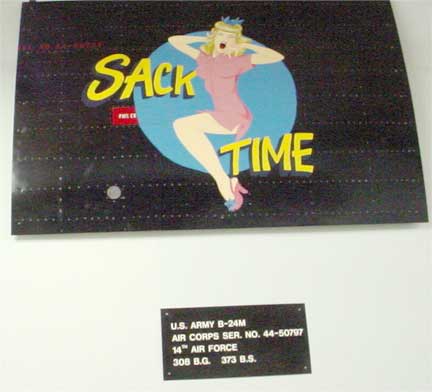|
|
General J.H. Doolittle
Tokyo Raiders Reunion, 2003
|
|
The Jimmy Doolittle Air and Space Museum Foundation and Travis Air Museum have an extremely interesting and wide variety of collections. Our weapons, engines, aircraft nose art, models, original photographs, aviation sculptures, military coins and uniforms are a delight to any craftsmen’s or artisans’ eye. The following represents an example of our holdings:
Nose Art: “Sack Time”

Travis Air Museum has a large display of nose art
created by artists Capt. Florence, Senior Airman Ortega, Senior Airman Welch,
Airman First Class Mackenzie, Heidi Couch and Staff Sergeant Bond.
By SSgt Bob Bond
Aircraft nose art is a special and unique form of folk art. It has provided a way for aircrews and support personnel to personalize their "babies," to make them different from the multitude of other aircraft. Its origin can be traced back to World War 1, when squadrons placed artwork consisting mainly of their insignias or emblems on their aircraft. Without question, World War II was the heyday for this kind of art and its unique expression of military life. During that war, thousands of B-17s, B-24s, B-25s, B-26s, B-29s, P-40s, P-38s, P47s and P-51s rolled from the aircraft assembly lines. Mass-produced, each model could only be differentiated by tail number, but tail numbers were for the "bean counters" or "ribbon clerks." The real difference was in the talent and imagination of the men who flew and maintained them. Few crew members or support personnel would talk about 124583 or 457652, but they surely knew and talked about "Sack Time," or "Final Objective," or "Dream Girl."
The inspiration for nose art, during World War II and later during the Korean Conflict, came from almost all areas of popular culture; girl friends, cartoons, comic strips, movies, matchbooks, calendars, you name it. However, the majority of nose art was inspired by the calendars and magazines of the time. The most widely copied artist was Alberto Vargas. Arguably the premier pin-up artist of our time, Vargas was the principle artist for Esquire Magazine and produced most of the art work for that magazine's pin-up page and calendars.
World War II, in particular, was a time when almost anything was allowed to be painted on aircraft. Allowing this kind of expression was seen as a way to boost morale and unit efficiency. But, in time, there were some excesses. This was particularly true in the case of pin-up girl nose art, so that by the end of the war, Army Air Corps censorship became evident in some of this art work.
Nose art all but disappeared following the Korean Conflict. It reappeared for a brief time during the Vietnam War, but disappeared once more at the end of that conflict because new command directives forbade nose art.
During the 1980s the United States Air Force began to reexamine its heritage, and despite complaints from the National Organization for Women -- because beautiful women were favorite subjects -- the Commander in Chief of the Strategic Air Command endorsed nose art on aircraft to re-instill tradition and pride.
Nevertheless, peacetime does not provide the ideal climate for this genre of art. It seems to take a war for nose art to survive and flourish. During the Gulf War, it did just that. By the time the conflict with Iraq ended in early 1991, almost everything within the theater that could fly had been decorated - some cute, some not so cute and some raunchy. When the aircraft returned home, most of the nose art seemed to disappear over night.
Models: Doolittle Tokyo Raiders’ B-25s and the USS Hornet
The Travis Air Museum has hundreds of meticulously created and professionally presented model aircraft of every shape and size. One of the best displays is a recreation of the 16 Doolittle Tokyo Raider’s B-25s on the deck of the USS Hornet.

Joe Tattersall also did a superb job of building a fiberglass hull
for the USS Hornet in the Doolittle exhibit.
Doolittle Tokyo Raiders and USS Hornet Exhibit
The Silicon Valley Scale Modelers, Scorpio Innovations, and Obscureco Aircraft donated a 1/72nd scale model of USS Hornet's (CV-8) flight deck and island and 16 1/72nd scale model of the B-25s used on the Doolittle raid. This exhibit also includes 16 1/1200th scale models of all the ships that participated in Task Force 16, which escorted the Hornet.
|
|
Task Force:
|
|
|
|
|
Ships:
|
Task Group 16.1
|
Task Group 16.2
|
|
|
Carriers:
|
USS Enterprise CV-6
|
USS Hornet CV-8
|
|
|
Cruisers:
|
USS Vincennes II CA-44
|
USS Northampton CA-26
|
|
|
|
USS Nashville II CL-43
|
USS Salt Lake City CA-25
|
|
|
Destroyers:
|
USS Gwin III DD-433
|
USS Balch DD-363
|
|
|
|
USS Grayson DD-435
|
USS Benham DD-397
|
|
|
|
USS Monssen DD-436
|
USS Ellet DD-398
|
|
|
|
USS Meredith DD-434
|
USS Fanning DD-385
|
|
|
Oilers:
|
USS Cimarron AO-22
|
USS Sabine AO-25
|
|
|
|
|
|
|
|
In addition, the submarines USS Thresher and USS Trout were operating off the Japanese coast, watching for enemy fleet movements and weather conditions.
|
|
Continue with Photography: Travis Heritage Collection
|
|